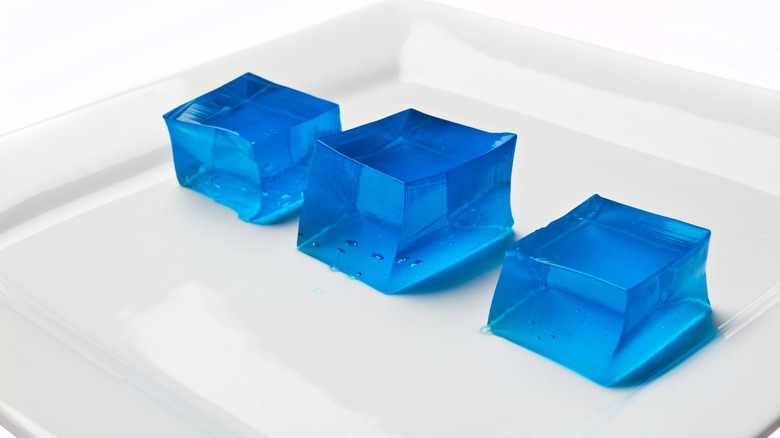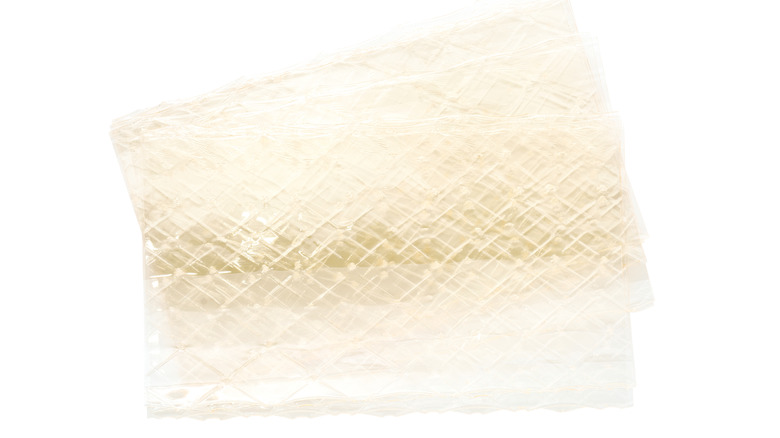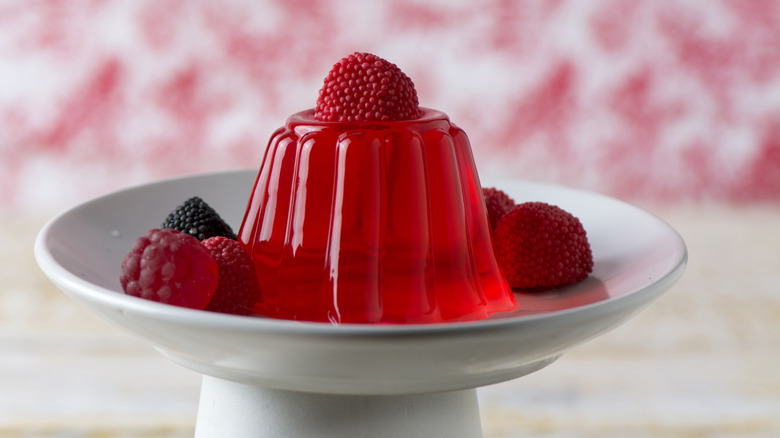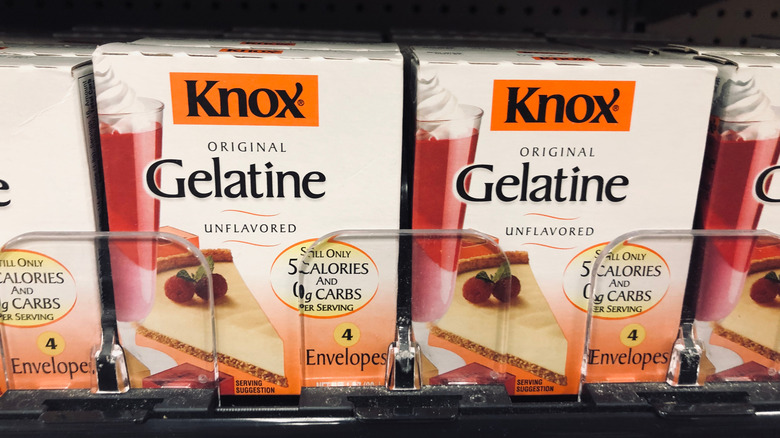Everything You Need To Know About Gelatin
There's something hypnotic about a mass of gelatin ever-so gently tapped, the way it shivers in a way that seems almost zoetic about its animation. There's a strange, ethereal beauty when it is studded with maraschino cherries, chunks of pineapple, and miniature marshmallows; their suspension seems like a moment trapped in time. And how can one forget the singular feeling of gelatin as wriggles and squirms about all corners of the mouth.
We take gelatin for granted, despite its unique qualities and place in the culinary lexicon. Plopped on a plate, we rarely question where it comes from. Beyond the dessert course, we scarcely think of the myriad ways it is used in the kitchen. That's why we're diving deep — not literally, though it sounds fun — into gelatin to get a more-rounded picture of this important ingredient. From its carnivorous origins to the strange uses people have found for it, gelatin is about to get its just desserts — pun very much intended.
Where does gelatin come from?
You may have once been told that gelatin is not vegetarian because it is made from the bones of cows and horses. You might even have thought that can't be true; it sounds too much like a tall tale meant to give the young and the gullible the heebie-jeebies. Well, according to Food Additives, whoever told you that was telling the truth. Gelatin is derived from the skin and bones of cows, pigs, and even fish through a process called hydrolysis.
If you're a lover of homemade soups and stews and have been inclined to make your own stock, you've likely been a party to this process. Ever reduce, say, a beef bone broth, chill it in the fridge, and pull it out only to find not a liquid but a jiggly meat jelly? That's the natural gelatin you've leached from those bones doing its thing.
Vegetarians and vegans, take heed. As The Kitchn explains, there are multiple plant-derived thickeners you can use, from agar, which comes from algae, to carrageenan, which is made from seaweed.
Gelatin's many forms
When gelatin is mentioned, desserts naturally jump to mind. Heck, the brand name Jell-O has become a genericized byword for almost any gelatin-forward sweet treat, commonly rendered as Jello. Take, for instance, the Jello mold, lovingly tributized by Epicurious. Really a class of desserts, Jello molds once held a special place in the mid-century American diet. Cooks stuffed them with everything from fruit to pretzels before serving heaping helpings at church potlucks and backyard barbecues.
Of course, if you talk about Jello molds, you can't overlook their savory-ish cousin, the Jello salad. In the early part of the 20th century, especially as the U.S. entered the post-WWII era, Jello became ubiquitous and played host to a variety of ingredients. Serious Eats' thorough history of Jello salads highlights some of the fascinating combinations that emerged. Lime gelatin with olives, celery, and vinegar, anyone? How about strawberry gelatin strewn with chopped tomatoes and pickles?
A pioneering woman
One unexpected benefit of gelatin came not in an edible form. Charles and Rose Knox were partners in life and in business, theirs being the Knox Gelatine Company, notes America Comes Alive. While Charles ran the day-to-day operations, Rose marketed the gelatin to women just like her with recipes.
Upon the death of her husband in 1908, Rose Knox took over management of Knox Gelatine — and capitulating to the men who worked there was not on her agenda. Women You Should Know details how she was pressured to sell the business, but decided to buck the gender expectations of the time, even releasing from employment a company executive who made known his opposition to her leadership.
Further, Rose pioneered changes in her business aimed at promoting equity and increasing her employees' standard of living. Still novelties in the early 20th century, Rose welcomed her employees through the front door, established a set five-day work week, and gave paid vacation and leave for illnesses. Her stewardship saw the company not only survive, but grow during the Great Depression, explains the Fulton County (NY) Historical Society. Knox also went on to develop gelatin for use in non-food applications, such as pharmaceuticals, where gelatin is still used today in dissolving pill capsules.
The next time you find yourself captivated by gelatin, give a nod to Rose Knox — who broke the mold while giving us recipes to put in one.



